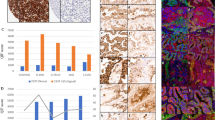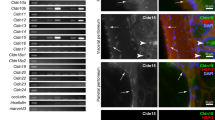Abstract
This study evaluates the cell surface expression of urokinase-type plasminogen activator (u-PA) and the capacity to bind exogenous urokinase as possible parameters for the distinction of various types of human lung tumours. Twelve different tumour cell lines including four small cell carcinoma, two large cell carcinoma, three squamous cell carcinoma, one adenocarcinoma and two mesothelioma cell lines of lung origin were investigated. Surface expression of endogenous u-PA was determined in a cellular radioimmunoassay (CRIA) using the u-PA-specific monoclonal antibody 98/6. To estimate additional u-PA binding capacity, exogenous two-chain, 54 kDa u-PA was employed in the CRIA. The influence of phorbol ester (PMA) treatment on expression and binding of these molecules was studied. Three different groups of lung tumour cell lines could be distinguished according to their expression of u-PA and u-PA-binding ability: (i) non small cell lung carcinoma (NSCLC) cell lines of squamous cell carcinoma/adenocarcinoma origin expressed small amounts of u-PA and bound little u-PA. Large cell carcinoma cell lines expressed high amounts of u-PA and bound large amounts of u-PA. In general, expression of u-PA and u-PA binding was enhanced after PMA treatment. (ii) Mesothelioma cell lines did not express u-PA, but were able to bind u-PA. (iii) Small cell carcinoma (SCLC) lines were devoid of surface-expressed u-PA and could not bind u-PA, both under untreated and PMA-treated conditions. It could thus be demonstrated that these three groups of lung tumour cell lines differ in their ability to express u-PA and to bind external u-PA. This may reflect the different in vivo growth behaviour and origin of the respective tumour groups.
This is a preview of subscription content, access via your institution
Access options
Subscribe to this journal
Receive 24 print issues and online access
$259.00 per year
only $10.79 per issue
Buy this article
- Purchase on Springer Link
- Instant access to full article PDF
Prices may be subject to local taxes which are calculated during checkout
Similar content being viewed by others
Author information
Authors and Affiliations
Rights and permissions
About this article
Cite this article
Schwartz-Albiez, R., Heidtmann, HH., Wolf, D. et al. Three types of human lung tumour cell lines can be distinguished according to surface expression of endogenous urokinase and their capacity to bind exogenous urokinase. Br J Cancer 65, 51–57 (1992). https://doi.org/10.1038/bjc.1992.10
Issue Date:
DOI: https://doi.org/10.1038/bjc.1992.10



